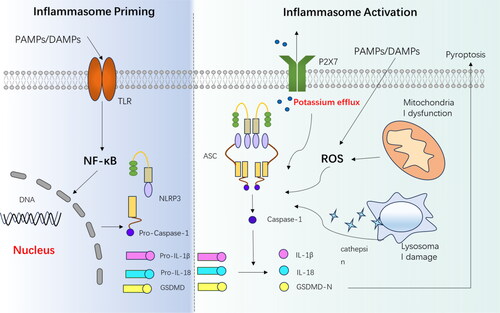Figures & data
Figure 1. The composition and activation of the NLRP3 inflammasome involve two main signals. In the priming signal, Toll-like receptors (TLRs) recognise pathogen-associated molecular patterns (PAMPs) and damage-associated molecular patterns (DAMPs), leading to the activation of the NF-κB pathway. This activation results in the increased expression of various components associated with the inflammasome. In the activation signal, the NLRP3 inflammasome is triggered by factors such as lysosomal damage, reactive oxygen species (ROS), and potassium efflux. Once activated, the inflammasome activates caspase 1, which then cleaves pro-IL-1β and pro-IL-18, generating active IL-1β and IL-18. Additionally, caspase 1 cleaves gasdermin D (GSDMD), and its N-terminal fragment (GSDMD-N) can create pores in the cell membrane, and induce pyroptosis. PAMPs,pathogen-associated molecular patterns; DAMPs,damage-associated molecular patterns; TLR, Toll-like receptor; IL-1β, interleukin-1β; IL-18, interleukin-18; ASC, associated speck-like protein; P2X7, P2X purinoceptor 7; ROS, reactive oxygen species.

